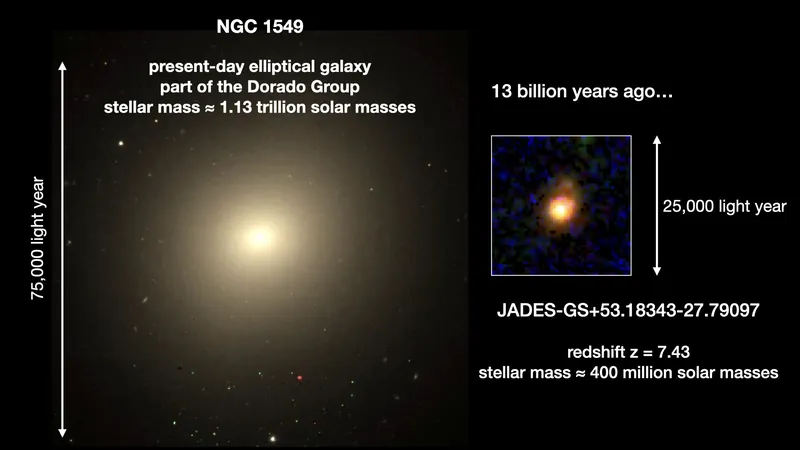
Astronomers Unravel 'Inside-Out' Galaxy Growth of a Mysterious Early Universe Galaxy
2024-10-11
Author: Jacques
Breakthrough Observation with JWST
In an astounding breakthrough, astronomers have utilized the NASA/ESA James Webb Space Telescope (JWST) to witness the unprecedented 'inside-out' growth of a galaxy dating back to just 700 million years after the Big Bang. This newly observed galaxy is significantly smaller than our Milky Way, measuring only one-hundredth of its size, yet it exhibits surprising maturity for such an early stage in the universe’s history.
Structure and Formation of the Galaxy
Like a bustling city, this young galaxy boasts a densely packed core of stars, with the density tapering off to its outskirts, reminiscent of suburban sprawl. Interestingly, star formation is accelerating in these outer regions, suggesting an expansion reminiscent of a city growing outward as its population increases.
Significance of Discovery
This marks the first time that astronomers have detected this type of galactic growth so far back in cosmic history. For decades, capturing images of galaxies in their infancy posed a considerable challenge, making this discovery a monumental achievement in astrophysics.
Insights from Research
Led by researchers at the University of Cambridge, this investigation sheds light on essential questions surrounding galaxy evolution and star formation. Dr. Sandro Tacchella, one of the co-lead authors, commented on the significance of this observation: 'The ability to gather data from billions of years ago allows us to explore how galaxies transform from mere clouds of gas into the sophisticated structures we see today.'
Traditional Understanding of Galaxy Evolution
Traditionally, galaxies have been understood to evolve through two primary mechanisms: either by accruing gas to form new stars or by combining with smaller galaxies. However, the question remains whether the early universe operated under different conditions, which astronomers are eager to explore with the capabilities of JWST.
Galactic Formation Process
Dr. Tacchella further elaborated on the formation process: 'Galaxies typically start as small, dense gas clouds that collapse under the force of gravity. As star formation increases, it’s akin to a figure skater pulling their arms in to spin faster. This process of accumulating gas also causes galaxies to adopt spiral or disc shapes as they expand.'
Current Status of the Observed Galaxy
The galaxy under observation, part of the JWST Advanced Extragalactic Survey (JADES) collaboration, is currently experiencing vigorous star formation. Despite its relative youth, its core density rivals that of modern massive elliptical galaxies, which house thousands of times more stars. The bulk of star formation appears to be occurring at greater distances from the core, indicating a star-forming ‘clump’ that exists even further out.
Rapid Growth Rate
Astoundingly, this galaxy doubles its stellar mass in its outskirts every 10 million years—a rapid growth rate that starkly contrasts with the Milky Way's doubling period of approximately 10 billion years. The high density of its core, combined with a robust star formation rate, indicates a reservoir of gas that is likely conducive to the formation of new stars. This scenario may also reflect the unique conditions present in the nascent universe.
Future Research and Questions
However, this discovery is just one piece of the cosmic puzzle. 'This is only one galaxy; we need to gather data on other galaxies from the same era,' noted Dr. Tacchella. 'Are all galaxies evolving in a similar fashion? By comparing findings across various galaxies throughout cosmic time, we hope to reconstruct a comprehensive narrative of galaxy growth and evolution, ultimately revealing how they have reached their current forms.'
Conclusion
As more data from JWST comes to light, astronomers are poised to uncover the mysteries surrounding early galaxies, navigating the expansive tapestry of the universe’s history and deepening our understanding of the cosmic phenomena that shaped it. Keep watching the stars, as we learn more about the secrets they hold!









 Brasil (PT)
Brasil (PT)
 Canada (EN)
Canada (EN)
 Chile (ES)
Chile (ES)
 España (ES)
España (ES)
 France (FR)
France (FR)
 Hong Kong (EN)
Hong Kong (EN)
 Italia (IT)
Italia (IT)
 日本 (JA)
日本 (JA)
 Magyarország (HU)
Magyarország (HU)
 Norge (NO)
Norge (NO)
 Polska (PL)
Polska (PL)
 Schweiz (DE)
Schweiz (DE)
 Singapore (EN)
Singapore (EN)
 Sverige (SV)
Sverige (SV)
 Suomi (FI)
Suomi (FI)
 Türkiye (TR)
Türkiye (TR)